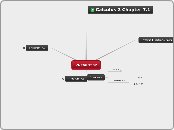MAT.105X
A4
Write an Equation of a Line
If you are given
The slope and y-intercept of the line, use y=mx+b and substitute those values into the equation.The slope of a line and a point on the line, use the point-slope formula: y-y1=m(x-x1). Substitute the slope for m and the point you are given for (x1,y1). Write your answer in slope-intercept or standard form.Two points on the line, find the slope of the line and then use the slope and either one of the points in the point-slope formula. Write your answer in slope-intercept or standard form.The equation of a horizontal line containing the point (c,d) is y=d.
The equation of a vertical line containing the point (c,d) is x=c.
Parallel and Perpendicular Lines
Parallel lines have the same slopes and different y-intercepts.
Two lines are perpendicular if their slopes are negative reciproclas of each other; i.e., if the product of their slopes is -1.
Determine if a Relation is a Function, and Find the Domain and Range
Function
A function is a special type of relation. If each element of the domain corresponds to exactly one element of the range, then the relation is a function.
The domain of a relation is the set of all values of the independent variable (the first coordinates in the set of ordered pairs).
The range of a relation is the set of all values of the dependent variable (the second coordinates in the set of ordered pairs).
Relation
A relation is any set of ordered pairs.
Given an Equation, Determine whether y is a Function of x and Find the Domain
Determining Domain
Are there any numbers that cannot be substituted for x?
For example, if x is in the denominator of a fraction, determine what value of x will make the denominator equal 0 be setting the denominator equal to zero. Solve for x. This x-value is not in the domain.
Domain and Range
If a relation is written as an equation so that y is in terms of x, then the domain is the set of all real numbers that can be substituted for the independent variable, x.
The resulting set of real numbers obtained for y, the dependent variable, is the range.
Use Function Notation and Find Function Values
Linear Function
A linear function has the form f(x)=mx+b, where m and b are real numbers, m is the slope of the line, and (0,b) is the y-intercept.
Function Notation
y=f(x) is called function notation, and it is read as, "y equals f of x."
y=f(x) means that y is a function of x (that is, y depends on x).
f(3) means to replace x with 3 and evaluate to find the value of y, or f(x=3), that corresponds to 3.
Graph a Line Given in Slope-Intercept Form
The slope-intercept form of a line is y=mx+b, where m is the slope and (0,b) is the y-intercept.
Find the Slope of a Line
The slope, m, of a line containing the distinct points (x1,y1) and (x2,y2) is given by
vertical change
slope = m = --------------------
horizontal change
y2-y1
= ------
x2-x1
rise
= ----
run
change in y
= -------------
change in x
m>0 implies the line increases from left to right
m<0 implies the line decreases from left to right
m=0 implies a horizontal line
Graph a Line by Plotting Points and Finding Intercepts
Horizontal and Vertical Lines
A vertical line has an equation of the form x=a, where a is a real number, and passes through the point (a,0) on the x-axis.
A horizontal line has an equation of the form y=b, where b is a real number, and passes through the point (0,b) on the y-axis.
Intercepts
An x-intercept for a linear equation in two variables is a point on the line with y-coordinate 0. That is, a point that looks like (a,0).
An y-intercept for a linear equation in two variables is a point on the line with x-coordinate 0. That is, a point that looks like (0,b).
Plotting Points
The graph of a linear equation in two variables, Ax+By=C, is a straight line. Each point on the line is a solution to the equation, and every linear equation in two variables has an infinite number of solutions.
Define a Linear Equation in Two Variables
A linear equation in two variables can be written in the form Ax+By=C (standard form) where A, B, and C are real numbers and where both A and B do not equal zero.
A solution to a linear equation in two variables is an ordered pair, (x,y), that satisifies the equation.









